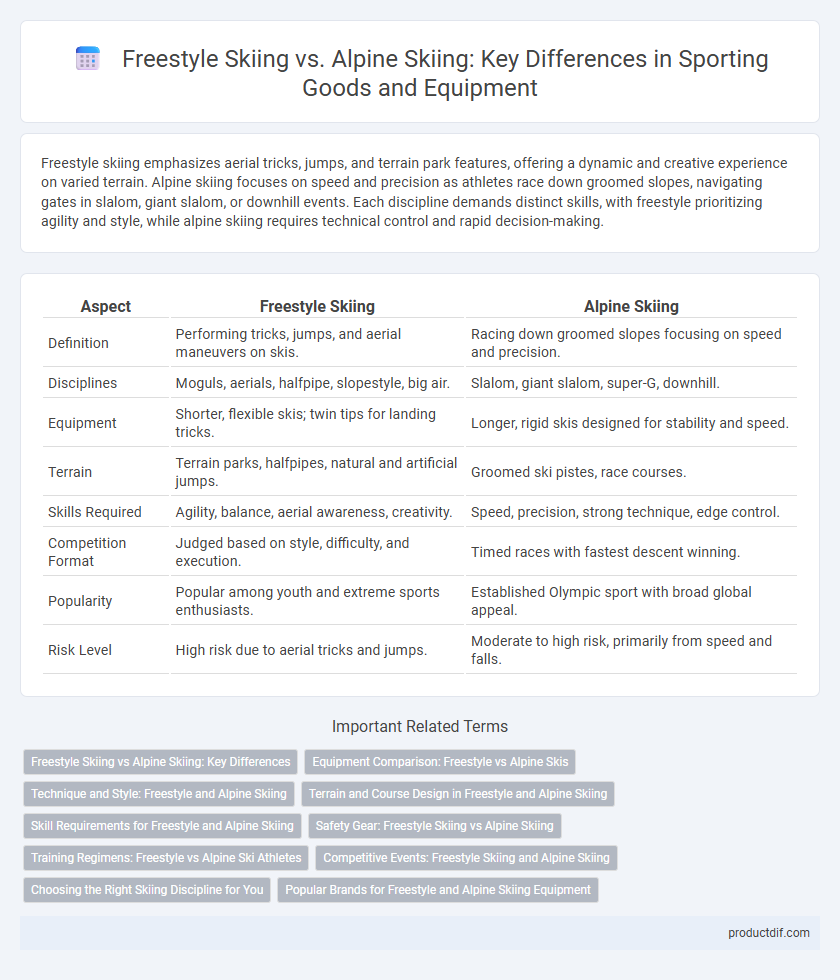Freestyle skiing emphasizes aerial tricks, jumps, and terrain park features, offering a dynamic and creative experience on varied terrain. Alpine skiing focuses on speed and precision as athletes race down groomed slopes, navigating gates in slalom, giant slalom, or downhill events. Each discipline demands distinct skills, with freestyle prioritizing agility and style, while alpine skiing requires technical control and rapid decision-making.
Table of Comparison
| Aspect | Freestyle Skiing | Alpine Skiing |
|---|---|---|
| Definition | Performing tricks, jumps, and aerial maneuvers on skis. | Racing down groomed slopes focusing on speed and precision. |
| Disciplines | Moguls, aerials, halfpipe, slopestyle, big air. | Slalom, giant slalom, super-G, downhill. |
| Equipment | Shorter, flexible skis; twin tips for landing tricks. | Longer, rigid skis designed for stability and speed. |
| Terrain | Terrain parks, halfpipes, natural and artificial jumps. | Groomed ski pistes, race courses. |
| Skills Required | Agility, balance, aerial awareness, creativity. | Speed, precision, strong technique, edge control. |
| Competition Format | Judged based on style, difficulty, and execution. | Timed races with fastest descent winning. |
| Popularity | Popular among youth and extreme sports enthusiasts. | Established Olympic sport with broad global appeal. |
| Risk Level | High risk due to aerial tricks and jumps. | Moderate to high risk, primarily from speed and falls. |
Freestyle Skiing vs Alpine Skiing: Key Differences
Freestyle skiing emphasizes aerial tricks, terrain park features, and creative jump execution, while alpine skiing centers on speed and precision through groomed downhill courses and slalom gates. Freestyle athletes require advanced acrobatic skills and balance to perform spins, flips, and rails, contrasting with alpine skiers who prioritize edge control, carving techniques, and timed runs. Equipment variations include twin-tip skis for freestyle maneuverability versus longer, rigid alpine skis optimized for stability and rapid turns.
Equipment Comparison: Freestyle vs Alpine Skis
Freestyle skis are typically shorter, more flexible, and twin-tipped to allow for aerial tricks and smooth landings, contrasting with alpine skis, which are longer, stiffer, and designed for speed and stability on groomed slopes. The bindings on freestyle skis often provide greater rotational freedom, enhancing maneuverability, whereas alpine ski bindings prioritize secure foot retention for precise edge control. Ski boots for freestyle tend to be softer to accommodate flexibility and shock absorption, while alpine boots emphasize rigidity to transfer maximum power during high-speed turns.
Technique and Style: Freestyle and Alpine Skiing
Freestyle skiing emphasizes aerial maneuvers, spins, and tricks executed on terrain parks, requiring advanced balance, agility, and creativity. Alpine skiing prioritizes speed and precision on groomed slopes, focusing on carving turns and maintaining optimal control during high-velocity descents. Both disciplines demand distinct technical skills, with freestyle highlighting expressive style and freestyle-specific equipment, while alpine skiing emphasizes aerodynamic positioning and edge control.
Terrain and Course Design in Freestyle and Alpine Skiing
Freestyle skiing terrain features specially designed parks with jumps, rails, half-pipes, and moguls to allow athletes to perform aerial tricks and complex maneuvers, emphasizing creativity and style. Alpine skiing courses prioritize steep, clearly marked downhill tracks with gates set to test speed, precision, and technical turning ability on varied natural slopes. The contrasting course designs reflect the distinct competitive demands: freestyle focuses on acrobatics within park settings, while alpine centers on fast, controlled navigation through challenging terrain.
Skill Requirements for Freestyle and Alpine Skiing
Freestyle skiing demands advanced aerial skills, balance, and creativity to perform tricks and jumps on varied terrain, emphasizing coordination and acrobatic ability. Alpine skiing requires strong technical skills for precise turns, speed control, and stability on steep, groomed slopes, prioritizing edge control and power. Mastery in freestyle involves dynamic body movement and spatial awareness, while alpine skiing focuses on precision, strength, and endurance.
Safety Gear: Freestyle Skiing vs Alpine Skiing
Freestyle skiing requires specialized safety gear such as flexible helmets, back protectors, and padded shorts to protect against high-impact falls and aerial tricks. Alpine skiing safety gear emphasizes rigid helmets, spine guards, and reinforced gloves designed to safeguard against high-speed collisions and sudden stops. Proper equipment tailored to each discipline significantly reduces injury risks, enhancing overall skier protection on varied terrains.
Training Regimens: Freestyle vs Alpine Ski Athletes
Freestyle skiing athletes emphasize agility, aerial skills, and strength training to master acrobatic maneuvers and landings, incorporating trampoline drills and park practice. Alpine ski athletes prioritize endurance, leg strength, and speed with rigorous on-slope training, including downhill runs, interval sprints, and balance exercises to optimize precision and control at high speeds. Both disciplines require tailored conditioning programs targeting sport-specific muscle groups to prevent injuries and enhance performance.
Competitive Events: Freestyle Skiing and Alpine Skiing
Freestyle skiing competitions include events like moguls, aerials, halfpipe, slopestyle, and ski cross, emphasizing acrobatic skills and creativity. Alpine skiing events focus on speed and precision with disciplines such as downhill, slalom, giant slalom, super-G, and combined. Both sports feature Olympic events regulated by the International Ski Federation (FIS), showcasing distinct athletic demands and styles.
Choosing the Right Skiing Discipline for You
Freestyle skiing emphasizes creativity and aerial tricks, appealing to those who enjoy dynamic terrain parks and jumps, while Alpine skiing prioritizes speed and precision on groomed slopes, ideal for individuals seeking high-performance racing and downhill excitement. Assess your skills, physical fitness, and personal interests to determine which discipline aligns better with your goals and style. Both require specialized equipment and training, so consider access to appropriate facilities and coaching when making your decision.
Popular Brands for Freestyle and Alpine Skiing Equipment
Popular brands for freestyle skiing equipment include Armada, Line Skis, and Faction, known for their durable and flexible gear designed for tricks and terrain parks. Alpine skiing enthusiasts often prefer brands such as Rossignol, Atomic, and Salomon, which specialize in high-performance skis and boots optimized for speed and precision on groomed slopes. Both disciplines emphasize equipment tailored to their unique styles, with freestyle brands focusing on innovation and maneuverability, while alpine brands prioritize stability and control.
Freestyle skiing vs Alpine skiing Infographic

 productdif.com
productdif.com